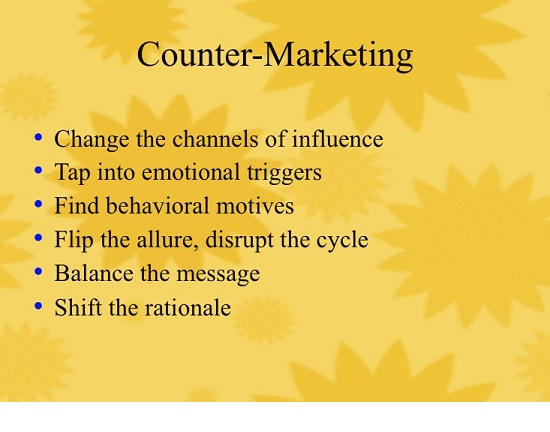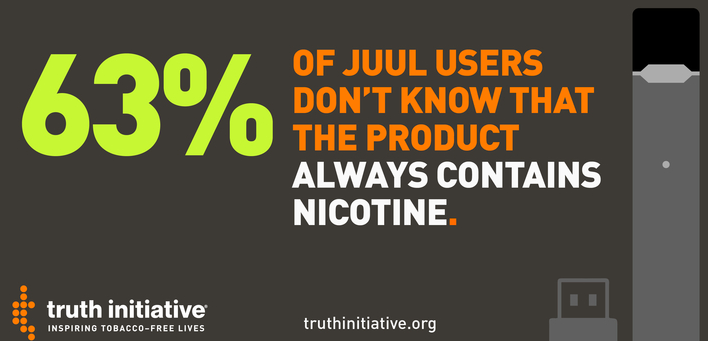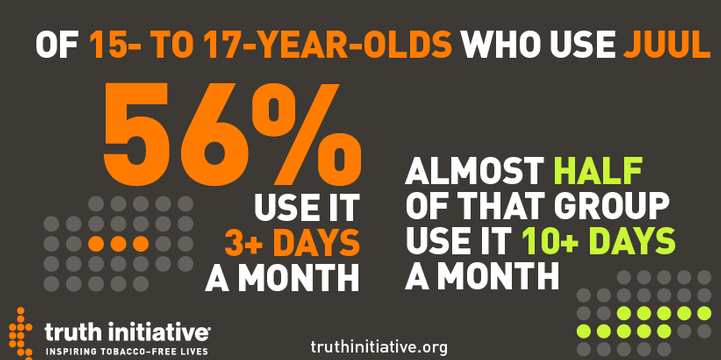
June 19, 2019 As an ad industry creative director I’ve spent years using applied science to flip messages in healthier directions by tapping into the same tactics that marketers use to hook their audiences early and often. (Here’s how I use marketing tactics to sell ‘reluctant readers’ on reading for fun, or getting kids to ‘eat green’ by using Shrek against junk food drek etc.)
Point being, when motivations and triggers are seen from a behavioral lens, it’s much easier to redirect the momentum into a positive public health frame by understanding youth demographics and developmental benchmarks of rebellion, coolness cache, peer acceptance and the risk rush.
I’ve run counter-marketing pilots against junk food, energy drinks, nutrition fads, gender stereotypes, even sexualization and objectification, but the sheer magnitude of the youth vaping ‘epidemic’ has made my head spin in terms of the speed, scale, and cynical marketing reach of big tobacco leveraging misinformation to the masses with goodwashing.
The CDC reports a 78% increase in high school use of e-cigarettes in just one year between 2017 and 2018, and the number of young adults between 18-21 who tried JUUL increased more than 400% from July 2017 to October 2018, but here’s the corker…(wait for it…) 63% of teens 15-24 surveyed didn’t even know Juul had ANY nicotine, much less the highest doses of it, according to Truth Initiative research.
 This level of high nicotine content, low perception is misinformation at best.
This level of high nicotine content, low perception is misinformation at best.
Couple it with the lag and drag in imparting research on newly discovered harmful outcomes, the low bar set by the FDA and slow mo policy piece with FDA process flounderings and you’ve got a situation where profiteering trumps public health. Big time. Ill-informed parents and even pediatricians often minimize vaping with false equivalence comparisons as “better than” tobacco when youth weren’t using tobacco to begin with, further citing “we don’t know yet” results of health harms which gives a neutral impression that vaping is just vaporized flavored air…that’s false, misleading and duplicitously dangerous.
So what’s a parent to do? Ask youth.
As with all youth work, “going to the source” directly should be smack dab at the center core of any planning to LISTEN TO youth perceptions.
All too often, parents jump the gun and search for “expert” guidance first, and wonder why anti-vaping tipsheets can fall flat and even merit an eyeroll from teens who think it’s much ado about nothing.
Adults who want to uncork this conversation effectively, much less counter-market it, need to start with a baseline of youth intake to even know how to respond and to what message. Credibility is key and without context, the whole topic of vaping can turn into a preach and teach tune out.
Using an e-cigarette analog… think of what smokescreens may have been ignited.
In short, you can’t counter-market with facts, nor educate effectively if you don’t even know what premise is sticking in order to use the right solvent for removal.
What mind pollution have they already inhaled, and how much knowledge toxicity has been imparted, by whom?
Are they even involved with vaping, or is it even a ‘thing’ in their friend group or peers at school?
Do they already know the nicotine risks and health outcomes but vape anyway?
Each answer prompts a different conversation.
 Part of the public health alarm is that vaping and e-cigarettes reversed a two-decade nosedive in teen smoking by duping and manipulating an entire generation minimizing the addictive and harmful effects of nicotine even while evidence is piling up to the contrary impacting adolescent bodily function significantly from head to toe…heart attacks and lung diseases, brain and sexual organ impairment, for starters. (CDC infographic)
Part of the public health alarm is that vaping and e-cigarettes reversed a two-decade nosedive in teen smoking by duping and manipulating an entire generation minimizing the addictive and harmful effects of nicotine even while evidence is piling up to the contrary impacting adolescent bodily function significantly from head to toe…heart attacks and lung diseases, brain and sexual organ impairment, for starters. (CDC infographic)
Upticks in the segue from vaping to tobacco are also minimized and challenged, all the while big tobacco alliances recruit scientists willing to add their names to ‘research’ sponsored by megabucks industry interests. The deception astounds…after hooking youth on megadoses of nicotine, illegal in most overseas markets, the vaping industry pulls off a massive bait and switch marketing campaigns with a ‘cessation’ message for older adults. Add to that, the illusion of ‘responsibility’ while industry waters down regulatory efforts… It’s as if the entire topic is one big con of smoke and mirrors.
Psych! Fooled you, young folks!
Could we reprise a behind the scenes Truth Initiative campaign, using“lift and reveal what’s behind the curtain” insights that helped big tobacco plunge into a two-decade nosedive thanks to youth pushback on corporate greed making a mint off their toxic health addictions?
Granted, it’s not as easy now with misinformation channels aplenty and megabucks tossed into the social media mix to add celebrity conduits and influencers. Then there are the Snapchat stories filled with ‘vaping ring’ challenges and fashion brand integration and built-in vape pen pockets…
Still, the premise of outing the marketing machinations and educating on what’s IN the stuff would seem like it may be a starting point…

…But we need to find out what’s working and what’s not in youth circles with counter-marketing today as well as what’s been tried, what already exists, and what large scale initiatives are already underway. (more on that in Part 4)
I decided to ask both youth vapers and non-vapers as well as public health experts what THEY thought the secret might be to turning this tanker around.
 Shaping Youth In Conversation With Danielle Ramo, Ph.D.
Shaping Youth In Conversation With Danielle Ramo, Ph.D.
In today’s Part 3 Q&A, Director of Research Operations at Hopelab and UCSF adjunct professor Department of Psychiatry and Weill Institute for Neurosciences Danielle Ramo, Ph.D. weighs in with her expertise, well-versed on the many aspects of this issue and also having written on this topic most recently in the San Francisco Chronicle, 4 Steps We Must Take To Curb Generation Vape
Here’s a small snapshot of what Danielle Ramo had to say:
Shaping Youth: Would a ‘Truth Campaign’ ‘rage against the machine’ style strategy work with “GenZ” vapers, and if not why not?
Danielle Ramo: The Truth Campaign’s strategy of pairing the notion of smoking with older white suit-wearing male executives who stand to profit off of nicotine addiction worked very well. In most of my work studying addictive behaviors in young people, even teens who smoke say they hate it and want to quit. So if we could do the same thing Truth did for smoking against the vaping industry that would likely have a powerful effect. When the tobacco company Altria bought a third stake in Juul at the end of 2018 that did make it easier to equate the vaping industry with big tobacco. Juul literally IS big tobacco now. That being said, we are starting in a different place with vaping than we were with cigarettes. Vaping has already used clever marketing strategies to make their product seem cool to GenZ, and that will not be as easy to counteract. So while there is a momentum against tobacco companies that can likely be used in changing attitudes toward vaping, awareness of industry tactics alone likely will not be as impactful as it was with cigarettes.
Shaping Youth: What methods and messaging do you think would best trigger a behavioral turnaround, given Gen Z has been duped and played into thinking that vaping is ‘no big deal and safe’ when it’s clearly not?
Should we focus on new health harms NOT widely known like impotence, secondhand toxic chemical exposure and nicotine inhalant data, heart attacks/agitation or redirect out of health harm to something else?
Danielle Ramo: The tactics that worked well to make Juul attractive specifically to GenZ included a focus on social media, and using influencers to push their products. Any campaign to trigger a turnaround should likely use similar tactics. Then there were the claims that their products were safe and help people quit smoking, even before any research has been able to show that (it is still not clear whether these products are effective to help adults quit smoking). A prevention campaign for GenZ should focus on what we know about why teen use is different from adult use (developmentally, body/brain wise) and how it is not “safe” for teens to use these products. While the research is still new, there are increasing numbers of studies showing that if teens start vaping they are more likely to become smokers than if they never vaped. GenZ should know that, as many do not seem to want to be smokers, even if they vape.
Shaping Youth: Would non-user peer to peer pressure work in a ‘health messaging’ humor approach, like the sardonic wit of John Oliver, or a College Humor Video series focusing on behavioral intervention? (e.g. “you do you, but keep it away from me” type of framing?)
Danielle Ramo: Humor can be a great marketing strategy, but if it’s not authentic, my sense is that GenZ would see through it pretty quickly. The best strategy is to co-develop and test any marketing campaign directly on the population it aims to support-a strategy that is core to our process at Hopelab. Counter-messaging is no exception. The best product and prevention campaigns include loads of test cycles. Involving peers directly in a campaign definitely feels appropriate given the access GenZ has to peers now through social media and the stronger influence peers can have than they did in previous generations due to this access. Plus, if it worked for Juul, why wouldn’t it work for changing the behavior Juul’s marketing campaigns have generated?
Shaping Youth: How do you think we could best inform GenZ teens peer to peer to flip the script? In addition to the manipulation factor, would cost and money spent on vaping resonate?
What if GenZ is already aware of the toxic health reverb and may want to quit but are already hooked and struggling with taking back their own agency? Could a non-vaper help a vaper in this challenge? Older siblings protecting younger siblings from early engagement? Suggestions?
Danielle Ramo: I’ve already mentioned ways that social media/influencers and using peers are likely going to be an important part of any widespread prevention campaign against vaping… Focusing on those who are currently doing it is a slightly different effort. In that case the intervention needs to become a bit more individually-focused. It has to focus on changing an addictive behavior that is already taking place rather than one that has not started yet. Widespread messages about how big tobacco owns Juul and a bunch of other vaping products is a start, but it is not the whole picture. Strategies that could work better to motivate GenZers who are already vaping are success stories (e.g., quitting vaping) from influential peers; stories that make vaping seem uncool from influential peers (e.g., “why I’d never date someone who vapes”), and challenging GenZ to bring about their own values and purposes in life and share how these are not consistent with vaping.
Special thanks to Danielle Ramo for her professional input…And since “Give youth the mic” is our motto here, we’ll be asking these same questions in part 4 to listen and learn from youth feedback to inform our strategies too…
We’ll hear from some ‘youth influencers’ in the UK and how regional differences factor in (it’s not remotely as prevalent there…YET) as well as hear from vapers who want to quit, some who feel it’s all just a phase and feedback from vapers and non-vaping youth at the middle school, high school and collegiate levels.
What are YOUR favorite ideas to curb and counter-market the vaping stranglehold on youth health and wellness? What’s working and what’s not from your point of view? Add your two cents in the comments or ping me on Twitter if you’d like to be one of our youth interviews…
Visual Credits: CDC vaping graphic, Truth Initiative stats charts








It’s hard to believe when people who’ve suffered from such addictions in the past speak out. Especially if such people aren’t in the same age. For example I suffered back then but I really don’t get my desired attention when talking to the young. I’d really encourage the young influencers to talk on it and share the experiences they faced. It will greatly help.
So heads up folks… unlike the comment above, we are instead getting a slew of (now deleted) spam comments purporting to ‘never be a smoker but it sounds like a great alternative’ while embedding a gazillion hotlinks to “dank carts vapes” sales…and such.
Pls. halt the fakery and vape hawking… it’s rude, obnoxious, and terribly unfortunate that it takes away from youth voices who might want to have a proactive, ‘on the other hand’ two-way conversation…We don’t need the reinforcement of bots and blather laced with a commodified business lens of deception. Find another site to troll and shill. Better yet, don’t.